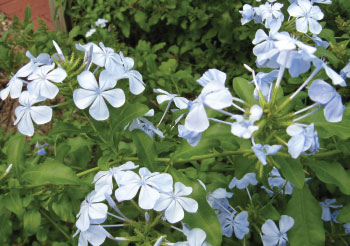
Community Gardening: Gardening with Perennials
by Lynn Barber / Published April 2015

Perennials are plants that thrive during the entire year and grow indefinitely. Annuals are plants that survive for one season, not one year. Perennials require less maintenance than annuals once they are established and provide a burst of color in the landscape. The purpose of this article is to share information about perennials with you, planting, propagation, and some great selections for the entire state—north, central, and south Florida.
The first step is to select the site to meet the needs of the plant. Consider sun or shade, wet or dry, soil type and pH, and mature plant size.
Lynn Barber, Agent
University of Florida/FAS Extension, Hillsborough
Lynn Barber, Agent, University of Florida/IFAS Exten-sion, Hillsborough County, is responsible for educating residents on the nine principles of the Florida Friendly LandscapingTM program. These principles include right plant right place, water efficiently, fertilize appropriately, mulch, attract wildlife, manage yard pests responsibly, recycle, reduce stormwater runoff, and protect the waterfront. Barber is past president of the Florida Association of Natural Resource Extension Professionals and has received numerous awards for programming, publications, and television and radio segments. As a Master Gardener, she has given back thousands of hours in environmental horticulture education to the community.
Preparing the landscape bed is very important because the perennials you are planting will be in that location for a very long time, unless you decide otherwise. If your soil is sandy, you should amend it with several inches of compost, manure, or peat, working the organic material into the top foot of the planting bed.
 The top of the root ball should be 10 percent above ground level. If the root ball is 10 inches, you should plant one inch above the ground level. Water thoroughly when planted and frequently until new growth is visible. Apply mulch so it will be two to three inches deep after it settles. Mulch is very important because it retains moisture in the soil, adds nutrients to the soil as it decomposes, moderates soil temperature, suppresses weeds, and reduces stormwater runoff and erosion from yards. Pull the mulch away from the base of the perennials. After perennials are established, they require minimal to no fertilizer. However, if the growth rate and plant appearance is not acceptable, use a slow-release fertilizer and follow the instructions. Propagation is by division, cuttings, and seeds.
The top of the root ball should be 10 percent above ground level. If the root ball is 10 inches, you should plant one inch above the ground level. Water thoroughly when planted and frequently until new growth is visible. Apply mulch so it will be two to three inches deep after it settles. Mulch is very important because it retains moisture in the soil, adds nutrients to the soil as it decomposes, moderates soil temperature, suppresses weeds, and reduces stormwater runoff and erosion from yards. Pull the mulch away from the base of the perennials. After perennials are established, they require minimal to no fertilizer. However, if the growth rate and plant appearance is not acceptable, use a slow-release fertilizer and follow the instructions. Propagation is by division, cuttings, and seeds.
Some of my favorite perennials and those that have been in the Bette S. Walker Discovery Garden, the demonstration/teaching garden in the courtyard of our Extension office, and in my home landscape as well, are described below. All these that are listed are suited for north, central, and south Florida.
Firespike (Odontonema cuspidate)—This plant can reach a height of two to six feet and a spread of two to three feet. It prefers soil pH that is slightly acidic to slightly alkaline, 6.0–7.2, and sandy loam soil texture. Well-drained soil moisture is needed. Firespike thrives in full sun and performs well in partial shade. It has medium-drought and low- to-no salt tolerance. This perennial attracts butterflies and hummingbirds.
Flax Lily (Dianella tasmanica ‘Variegata’)—Flax Lily has a fast growth rate, can reach a height and spread of one to two feet, and prefers soil pH that is acidic to slightly alkaline, 4.5–7.2. Any soil texture works fine, from clay loam to sandy loam, from sand to sandy clay. Well-drained soil moisture is needed. Flax Lily thrives in full sun and performs well in partial shade. It has high-drought tolerance and produces small, blue and yellow flowers.
Plumbago (Plumbago auriculata)—This fast-grow- ing perennial can reach a height of 6–10 feet and a spread of 8–10 feet. Plum-bago prefers soil pH that is acidic to slightly alkaline, 4.5–7.2. Any soil texture works fine, from clay loam to sandy loam, from sand to sandy clay. Well-drained soil moisture is needed. This plant has medium-drought and low-to-no salt tolerance. It requires full sun, attracts butterflies, and produces blue or white year-round flowers.
St. Bernard’s Lily (Anthericum liliago)—Another fast-growing perennial, St. Bernard’s Lily, can reach a height of one to one-and-a-half feet and a spread of a half to one foot. It prefers soil pH that is slightly acidic to slightly alkaline, 6.0–7.2. Any soil texture works fine, from clay loam to sandy loam, from sand to sandy clay. Well-drained soil moisture is needed. This plant has medium-drought tolerance, and performs best in full sun and well in partial shade. It produces white, spring flowers.
Please see the University of Florida publication, Gardening with Perennials in Florida, by Sydney Park Brown, at edis.ifas.ufl.edu/ pdffiles/MG/MG03500.pdf, from which this article was adapted. As always, follow the landscape or architectural control procedures in your deed restrictions before making changes. For more information about the nine principles of the Florida-Friendly LandscapingTM Program or for assistance with gardening-related ques- tions, contact your local Extension office and/or visit the University of Florida web- site solutionsforyourlife.com or edis.ifas.ufl.edu.


